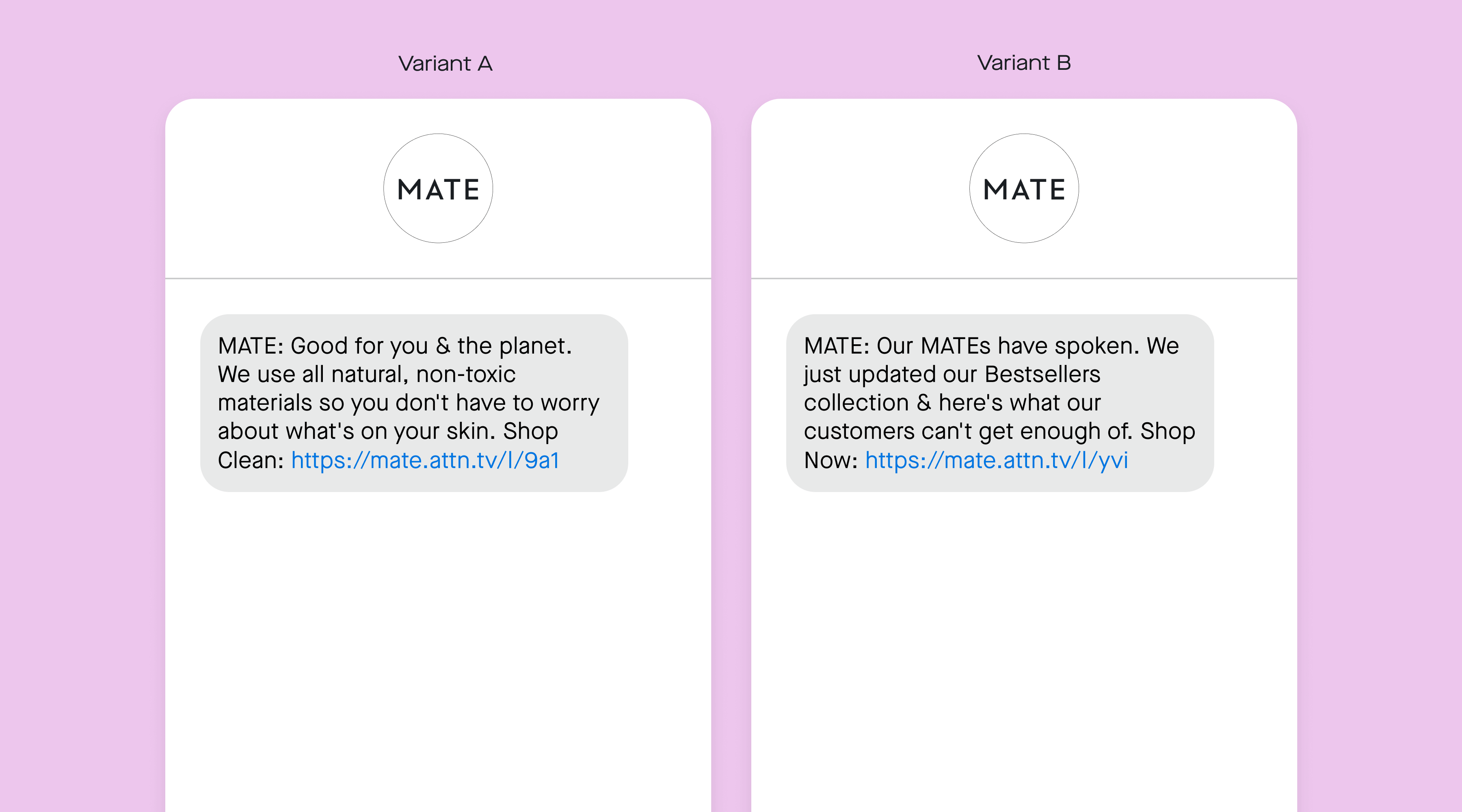
New releases
A smarter, simpler Attentive
Explore new features →
Explore new features →


We sat down with Cleo von Siebenthal, Director of E-Commerce & Digital Marketing at MATE the Label, to talk about how the brand uses marketing to educate consumers about ethical fashion, the story behind their first annual Impact Report, and how they use SMS as a VIP communication channel.
Before joining MATE the Label, von Siebenthal held e-commerce roles at a direct-to-consumer menswear company, Buck Mason, and a media startup called Tastemade, where she oversaw their community management and launched their first Shopify store.
Every conversation begins with sustainability. Selling clothes comes second.
We recently hired a sustainability manager to work closely with our factories and analyze the impact of our clothing, which enables us to stand behind what we say in our marketing and be transparent with our customers about our efforts.
Buyer behavior has shifted over the past year. People are more conscious about where they spend their dollars—and a lot of brands have capitalized on that by claiming to be sustainable. At MATE, we want to make sure people are aware of the genuine efforts we're putting in behind the scenes.
- Cleo von Siebenthal, Director of E-Commerce & Digital Marketing at MATE the Label
But we don’t want to come off as high-brow, so we have to take all of our complex research and make it digestible for our audience. We have to figure out how to communicate this information to someone who already knows a lot about sustainable and ethical clothing manufacturing and—at the same time—to someone who's trying to become a more conscious consumer. We have to balance tailoring the message with keeping it consistent across all of our channels. That’s where my role comes in.
When we redesigned our website, for example, we focused on creating core pages that touch on different elements of sustainability. We have a Materials page that breaks down all of the fabrics we use and the chemicals and dyes that we stay away from using. We have a Factories page where we highlight every single factory we work with, where each one is located, and the number of employees—to be transparent about our supply chain.

We’re also investing in getting certifications. We recently became Climate Neutral Certified, and we have a strict Code of Conduct that we have all of our dye houses and factories sign and adhere to.
We published our first Impact Report at the end of 2020 to measure the environmental footprint of our clothing. It started with the research that our sustainability manager was doing. For the first time, we were able to sit back and say, "Wow, we achieved a lot as a company. How can we talk about this?"
We wanted to be open about everything we accomplished and the work that went into achieving those goals. But we also had a lot of information to condense down into a visually digestible format. We created this beautiful landing page and added the report to the sustainability menu on our website—and then we had to think about how to drive traffic to it.
Our SMS subscribers are some of our most engaged consumers, so we gave them early access to read the report. If someone gives you permission as a brand to text them on their personal phone, chances are they care a lot about you.

When we looked at the time spent on the page, it was clear that our customers do really care. We saw that people spent time scrolling through the entire report and got to the very end.
We're going to continue to build an Impact Report every year to make sure our customers know we're fully transparent about our efforts.
We have an incredibly strong community called the Dress Clean Advocate Program. There are about 150 advocates that have been selected through an application process, ranging from micro-influencers to people with 40,000+ followers.
All of our Dress Clean Advocates have one thing in common: they're passionate about sustainability and want to help spread the Dress Clean mission. So when we came out with the Impact Report, we wanted to go beyond just sending out an email, a text, and posting about it on social media.
It was about connecting with our community of advocates, walking them through our efforts and the results, and then having them share that message with their audiences as well. We saw this ripple effect where people were talking about the report and sharing it with their friends.
We typically start with one core message on our email channel, and then we tailor the content and the visuals for our other platforms based on what we've seen perform best in previous campaigns.
We introduced reviews to our website early on when I joined MATE. I know that, as a consumer, I trust what other customers say about a product more than what the brand says, so it was a no-brainer for us to add them. We saw increased conversation rates on our site, but we also learned that customers who did leave reviews had a higher lifetime value.

People started leaving reviews referring to other reviews—it's like a trust-building exercise. We started A/B testing using reviews in our emails, and it worked, so we rolled them out in our paid ads, testing one graphic with a customer review overlay against one without it. Then we moved the test to SMS, and again, reviews continue to perform well with our audience.
Our core shopper is a woman between the ages of 18 up to 60. But really, it's the person who cares about what they put on their skin and wants to be more conscious about what they wear. It ranges from people who are highly aware of ethical fashion to those who are just starting to become aware of clothing sustainability—and I think that has a lot to do with our brand voice and making sure that we're approachable, not intimidating.
We know this approach resonates because we survey our customers, asking them what types of content they want to see more of from us. Time and time again, the sustainability topic comes up. They want to be more conscious shoppers and, in a lot of our educational messaging, we don't only talk about our products and what we do. We also talk about general ideas like, what is a carbon offset and how do you purchase one?
We also run polls on our Instagram Stories where we ask our followers what content they're most interested in, and sustainability always wins. When we send email and SMS campaigns about sustainability, it's clear through the performance metrics that people are engaged: open rates and click-through rates are higher, while unsubscribe rates are lower.
We also see positive messages in our customer care inbox from our community, responding to our marketing emails. People want to better themselves across all of their purchasing touchpoints.
We lead with our clean clothing. For our prospecting audience on paid social, which is a strong outlet for us, we have specific ads that touch on the life cycle assessments (LCAs) of our products. We'll compare our MATE Classic Jogger, for example, to a conventional classic jogger, so we're using that first touchpoint to show how we're doing better in carbon emissions and water usage. It's not just a photo of a pair of sweatpants, but rather, data and metrics that are relevant to potential customers.
Our email welcome flow takes customers through various sustainability touchpoints, such as transparency into our factories and how to care for MATE clothing in a thoughtful way.

We’ve also been A/B testing in our SMS welcome series, promoting our use of all-natural, non-toxic materials versus a call-to-action to shop our best-selling products. Both variants perform well, but we've seen that subscribers who receive the sustainability message have a higher retention rate, so we know they believe in our brand.
Something we've always thought about at MATE is how to become more omnichannel with our marketing. We have our email and social media channels figured out, and we knew that SMS was an area of opportunity for us. No one on our team had worked with SMS before, so we went into launching our text channel with a very open mind, ready to learn.
We used our first month to test whatever we could on SMS. That time was so valuable because, with every single send, we were improving upon a previous test. We're confident in what we send out now because the test results are consistently the same.
We’ve found that our customers really want to hear from us—and SMS feels a lot more personal for communicating with them. We use it as a VIP channel to give our subscribers exclusive first access. Whenever we have a sale, we'll encourage people to sign up for our SMS list to be the first to know, and the people who sign up stay subscribed to our list well after the sale is over.
SMS was a supplementary channel for us at first, but now, it's one of our primary marketing channels. The open rates are higher compared to email, and our subscribers are highly engaged. The ability to share messages directly with our customers almost ensures they're going to open them—and we see incredible ROI per send.
- Cleo von Siebenthal, Director of E-Commerce & Digital Marketing at MATE the Label
We just launched a partnership with Beam, so shoppers can select a non-profit to support at checkout, and MATE will donate 1% of their purchase to that organization.
We're also working on some fun new products and even a few new categories. I can't say much more than that, but we're going to be using SMS as a channel to send out teasers, so sign up to stay in the know.
Interested in how other leading fashion brands are using text messaging to connect directly with their consumers? Browse Texts We Love to discover impactful SMS marketing examples.